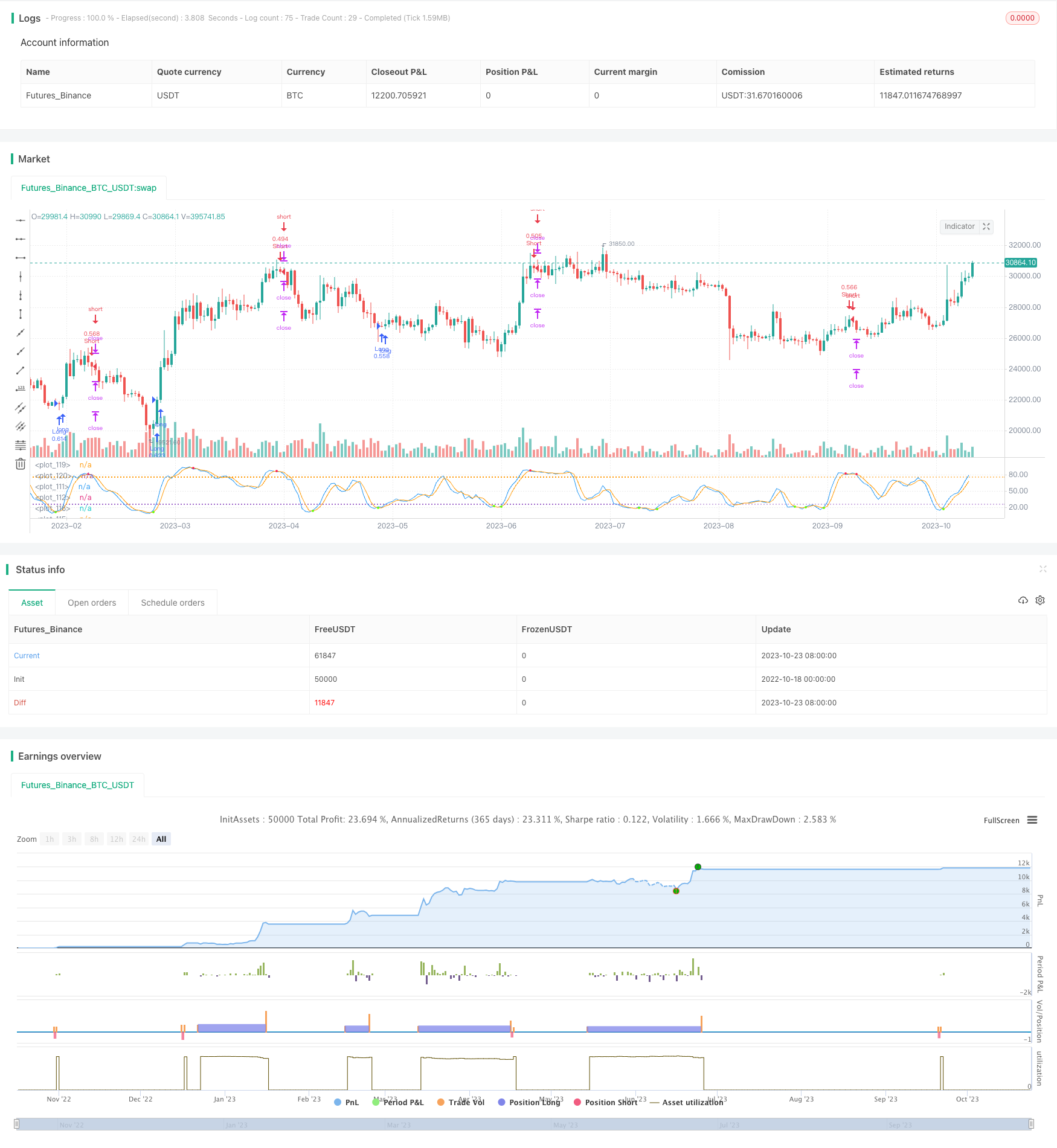
概述
该策略的主要思想是设置两个止盈点,当第一个止盈点被触发时,将止损点移至入场价格,防止止损被刮边。
策略原理
本策略基于布林带指标和Stochastic指标入场。当价格超出布林带上轨时做空,当Stochastic指标显示超卖时做多。
具体来说,策略的入场逻辑是:
当收盘价低于布林带下轨,且Stochastic K线下穿D线时做多入场
当收盘价高于布林带上轨,且Stochastic K线上穿D线时做空入场
该策略设置两个止盈点,第一个止盈点固定为200点,第二个止盈点固定为500点。
当价格移动过程中第一个止盈点被触发时,本策略会将止损点移至入场价格。这样可以锁定第一阶段的利润,同时防止止损被价格波动刮边。
当第二个止盈点被触发或者止损点被触发时,本策略会全部平仓。
策略优势
这种两阶段止损策略最大的优势在于可以实现盈利的锁定,同时防止止损被价格波动刮边。通过移动止损点到入场价格,可以减小止损被刮边的概率,保护利润。
另一个优势是该策略采用了布林带指标判断价格波动范围和Stochastic指标判断超买超卖的组合策略,这两个指标互为补充,可以提高入场的准确率。
策略风险
该策略主要的风险在于布林带指标和Stochastic指标都可能产生错误信号。如果布林带范围计算错误,将导致错失入场时机或者产生错误信号。如果Stochastic指标产生假突破,也会导致错误入场。
此外,移动止损点到入场价格也存在被再次刮边的风险。如果行情出现V型反转,止损点有可能会被第二次触发。
为降低这些风险,可以调整布林带参数,优化Stochastic指标参数组合,并适当提高止损点间距。
策略优化方向
这种两阶段止损策略还可以进一步优化:
可以测试不同的参数组合,优化布林带参数和Stochastic参数,找到最优参数组合。
可以测试不同的止盈止损点设置,优化止盈止损点的大小,找到最优配置。
可以加入其它指标,例如移动平均线等,形成多指标组合策略,提高入场准确率。
可以研究不同的止损点移动逻辑,例如移动到一定间距之外,而不是入场价格。
可以增加止损点移动次数,设置三个或更多阶段的止损移动。
总结
本策略采用布林带指标和Stochastic指标判断入场时机,设置两个止盈点,在第一个止盈点达到后移动止损点到入场价格,形成两阶段止损策略。这种策略可以有效锁定利润并防止止损被刮边。策略优势突出,但也存在一定改进空间,通过参数优化、多指标组合、止损点逻辑调整等方式可以进一步完善该策略。
/*backtest
start: 2022-10-18 00:00:00
end: 2023-10-24 00:00:00
period: 1d
basePeriod: 1h
exchanges: [{"eid":"Futures_Binance","currency":"BTC_USDT"}]
*/
// This source code is subject to the terms of the Mozilla Public License 2.0 at https://mozilla.org/MPL/2.0/
// © fpsd4ve
//@version=5
// Add Bollinger Bands indicator (close, 20, 2) manually to visualise trading conditions
strategy("2xTP, SL to entry",
overlay=false,
pyramiding=0,
calc_on_every_tick=false,
default_qty_type=strategy.percent_of_equity,
default_qty_value=25,
initial_capital=1000,
commission_type=strategy.commission.percent,
commission_value=0.01
)
// PARAMETERS
// Assumes quote currency is FIAT as with BTC/USDT pair
tp1=input.float(200, title="Take Profit 1")
tp2=input.float(500, title="Take Profit 2")
sl=input.float(200, title="Stop Loss")
stOBOS = input.bool(true, title="Use Stochastic overbought/oversold threshold")
// Colors
colorRed = #FF2052
colorGreen = #66FF00
// FUNCTIONS
// Stochastic
f_stochastic() =>
stoch = ta.stoch(close, high, low, 14)
stoch_K = ta.sma(stoch, 3)
stoch_D = ta.sma(stoch_K, 3)
stRD = ta.crossunder(stoch_K, stoch_D)
stGD = ta.crossover(stoch_K, stoch_D)
[stoch_K, stoch_D, stRD, stGD]
// VARIABLES
[bbMiddle, bbUpper, bbLower] = ta.bb(close, 20, 2)
[stoch_K, stoch_D, stRD, stGD] = f_stochastic()
// ORDERS
// Active Orders
// Check if strategy has open positions
inLong = strategy.position_size > 0
inShort = strategy.position_size < 0
// Check if strategy reduced position size in last bar
longClose = strategy.position_size < strategy.position_size[1]
shortClose = strategy.position_size > strategy.position_size[1]
// Entry Conditions
// Enter long when during last candle these conditions are true:
// Candle high is greater than upper Bollinger Band
// Stochastic K line crosses under D line and is oversold
longCondition = stOBOS ?
low[1] < bbLower[1] and stGD[1] and stoch_K[1] < 25 :
low[1] < bbLower[1] and stGD[1]
// Enter short when during last candle these conditions are true:
// Candle low is lower than lower Bollinger Band
// Stochastic K line crosses over D line and is overbought
shortCondition = stOBOS ?
high[1] > bbUpper[1] and stRD[1] and stoch_K[1] > 75 :
high[1] > bbUpper[1] and stRD[1]
// Exit Conditions
// Calculate Take Profit
longTP1 = strategy.position_avg_price + tp1
longTP2 = strategy.position_avg_price + tp2
shortTP1 = strategy.position_avg_price - tp1
shortTP2 = strategy.position_avg_price - tp2
// Calculate Stop Loss
// Initialise variables
var float longSL = 0.0
var float shortSL = 0.0
// When not in position, set stop loss using close price which is the price used during backtesting
// When in a position, check to see if the position was reduced on the last bar
// If it was, set stop loss to position entry price. Otherwise, maintain last stop loss value
longSL := if inLong and ta.barssince(longClose) < ta.barssince(longCondition)
strategy.position_avg_price
else if inLong
longSL[1]
else
close - sl
shortSL := if inShort and ta.barssince(shortClose) < ta.barssince(shortCondition)
strategy.position_avg_price
else if inShort
shortSL[1]
else
close + sl
// Manage positions
strategy.entry("Long", strategy.long, when=longCondition)
strategy.exit("TP1/SL", from_entry="Long", qty_percent=50, limit=longTP1, stop=longSL)
strategy.exit("TP2/SL", from_entry="Long", limit=longTP2, stop=longSL)
strategy.entry("Short", strategy.short, when=shortCondition)
strategy.exit("TP1/SL", from_entry="Short", qty_percent=50, limit=shortTP1, stop=shortSL)
strategy.exit("TP2/SL", from_entry="Short", limit=shortTP2, stop=shortSL)
// DRAW
// Stochastic Chart
plot(stoch_K, color=color.blue)
plot(stoch_D, color=color.orange)
// Circles
plot(stOBOS ? stRD and stoch_K >= 75 ? stoch_D : na : stRD ? stoch_D : na, color=colorRed, style=plot.style_circles, linewidth=3)
plot(stOBOS ? stGD and stoch_K <= 25 ? stoch_D : na : stGD ? stoch_K : na, color=colorGreen, style=plot.style_circles, linewidth=3)
// Levels
hline(75, linestyle=hline.style_dotted)
hline(25, linestyle=hline.style_dotted)